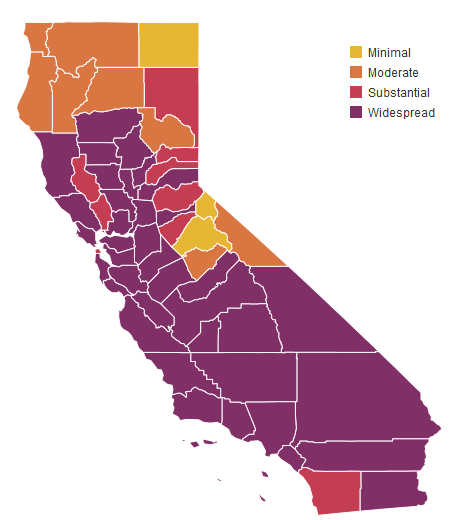California Implements New Statewide Framework Governing COVID-19 Restrictions
On August 28, 2020, California Governor Gavin Newsom released a new statewide COVID-19 restriction framework on the State’s COVID-19 website. With the new framework—given the official name “Blueprint for a Safer Economy”—the State has replaced the old “County Monitoring List” approach that was in place during much of July and August 2020, in favor of a new, more nuanced “four-tiered” framework.
The State explains that the new approach “is the next evolution of our response. We’ve revised the criteria and the time between changing tiers. We’ve made it easy for counties to see how changes affect the disease’s trajectory and for businesses and customers to plan ahead. And we’ve given Californians one place to look up whether a business or activity is allowed near them.” In practice, the new approach does not differ that much from the old approach, except that the new approach offers more nuance for counties to move along different phases of reopening under different restrictions as outbreaks wax and wane.
Under the new framework, “[e]very county in California is assigned to a tier based on its rate of new cases and positivity. At a minimum, counties must remain in a tier for at least 3 weeks before moving forward. Further, “[t]o move forward, a county must meet the next tier’s criteria for two consecutive weeks. If a county’s metrics worsen for two consecutive weeks, it will be assigned a more restrictive tier.” The State has said that “[d]ata is reviewed and weekly and tiers are updated on Tuesdays.”
The four tiers are as follows, from most restrictive to least: (1) Widespread; (2) Substantial; (3) Moderate; and (4) Minimal. The tiers are determined based on the number of new cases and the percentage of positive tests within a given county, with the higher figure dictating the tier. The State writes that “[a]ctivities and businesses that have a lower risk of spreading COVID-19 are allowed to open sooner. Higher-risk activities or businesses aren’t allowed until later tiers.” Today, most of the State’s highly populated areas fall under the “Widespread” tier, with the exceptions of San Diego and San Francisco Counties, which fall under the “Substantial” tier.
Given the increased nuance of the new framework, it is not possible to describe the restrictions for every single industry in succinct form. However, certain industries have seen eased restriction statewide. For instance, even in the most restrictive “Widespread” tier, all retail and shopping centers may now open at maximum 25% capacity with modifications (and with common areas and food courts closed), and hair salons and barbershops may open indoors with modifications.
For offices of non-essential businesses, the restrictions are as follows: for “Widespread” and “Substantial” counties, these offices may not open, and workers can only work remotely. For “Moderate” and “Minimal” counties, these offices can open indoors with modifications, though the State still does “[e]ncourage working remotely” for those counties.
Below is a map provided by the State’s COVID-19 Website that shows the current tier status of every County in the State:

(Graphic Source: https://covid19.ca.gov/safer-economy/, last accessed August 31, 2020)
The State’s COVID-19 website also provides the ability for users to enter a county or business/activity to determine the State’s current restrictions for each.
AALRR will continue to monitor California’s handling of COVID-19 restrictions for every county in the State. If you have any questions about what restrictions apply to you, or what you need to do to stay in compliance with COVID-19 laws, orders and regulations, please contact the authors or the other attorneys at AALRR who can provide advice and counsel specific to your particular circumstances.
This AALRR publication is intended for informational purposes only and should not be relied upon in reaching a conclusion in a particular area of law. Applicability of the legal principles discussed may differ substantially in individual situations. Receipt of this or any other AALRR publication does not create an attorney-client relationship. The Firm is not responsible for inadvertent errors that may occur in the publishing process.
© 2020 Atkinson, Andelson, Loya, Ruud & Romo
Attorneys
 Partner562-653-3200
Partner562-653-3200
